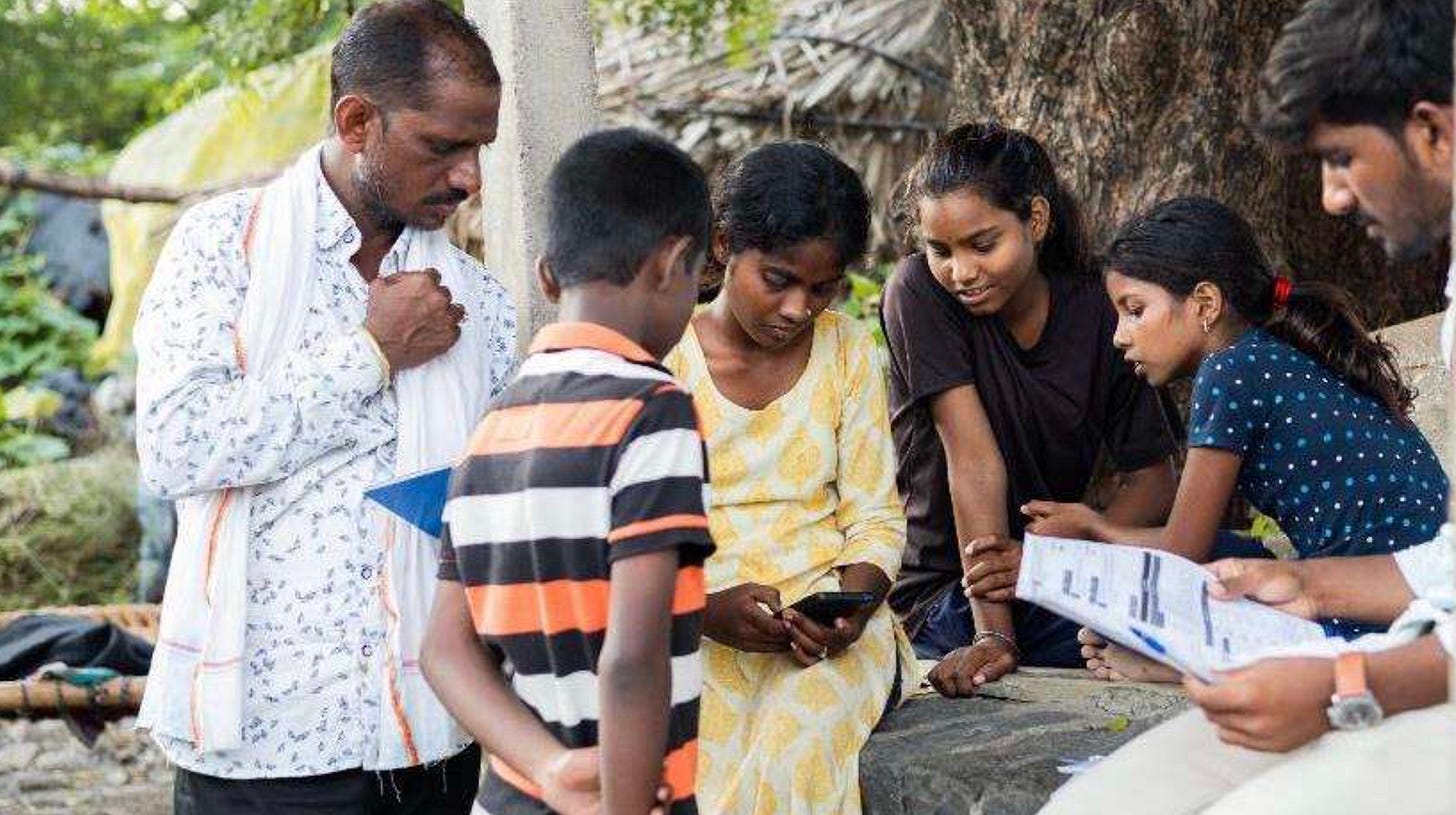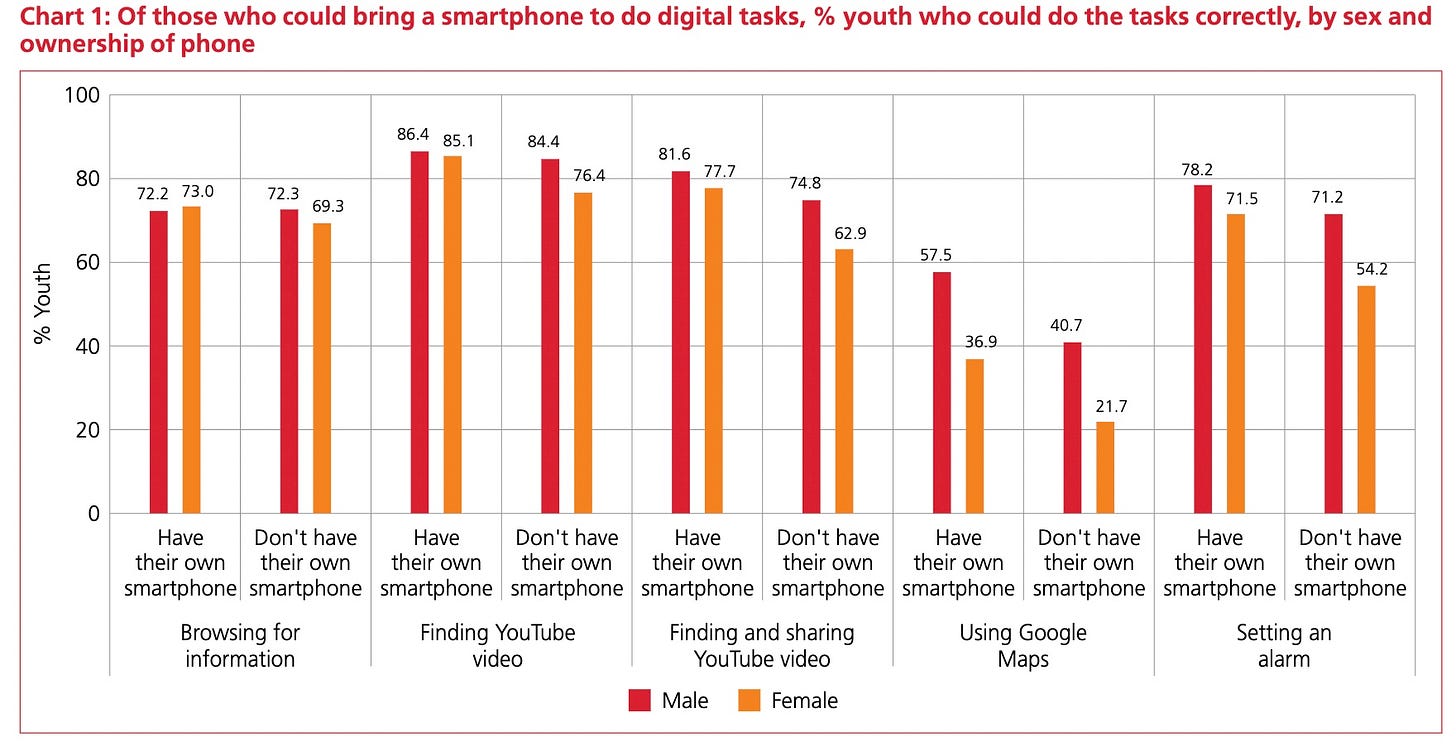India's Digital Dividend
ASER 2023 confirms the growing embrace of digital technologies by India's rural youth, setting the stage for the harvest of digital dividends. EPISODE #160
Dear Reader,
A very happy Monday to you.
Last week Pratham Education Foundation released its Annual Status of Education Report (ASER) 2023.
It is a large-scale citizen-led rural household survey, which among other things, revealed that 90% of India’s rural youth (14-18 years) have a smartphone in the household and know how to use it. Combined with the growing digital outreach by government and business this means Indian society is more connected than before.
Together with the rapid democratisation of basics like education, electricity, banking, drinking water and so on, this sets the stage for India to harvest digital dividends: growth, jobs and services. This week I explore this theme. Do read and share your feedback.
The cover picture a very evocative snapshot of this week’s theme sourced from ASER 2023 report.
A big shoutout to Balesh, Niranjan, Atul, Premasundaran, Sidhartha, Surendra, Aashish, Lakshmisha, and Gautam for your informed responses, kind appreciation and amplification of last week’s column. Once again, grateful for the conversation initiated by all you readers. Gratitude also to all those who responded on Twitter and Linkedin.
Unfortunately, Twitter has disabled amplification of Substack links—perils of social media monopolies operating in a walled garden framework. I would be grateful therefore if you could spread the word. Nothing to beat the word of mouth.
Reader participation and amplification is key to growing this newsletter community. And, many thanks to readers who hit the like button😊.
Beyond Basics
Last week Pratham Education Foundation released its Annual Status of Education Report (ASER) 2023. The findings of this large-scale citizen-led rural household survey were revealing.
At one level the survey showed that 87% of rural youth in the age category of 14-18 years were enrolled in some educational institution. In other words, the proportion of out-of-school children in rural India is witnessing a secular decline.
Compared to ASER 2017, the proportion of India’s young who have completed eight or more years of schooling went up from 81% to 84% in ASER 2023.
The downside though is that foundational literacy and numeracy, which have been plumbing lows for decades, have either declined or not improved sufficiently.
Between the two ASER surveys, the proportion of 14-18 year olds who could read a Standard II text book declined from 76.6% to 73.6%; while their ability to solve a simple Standard III/IV division problem rose marginally from 39.5% to 43.3%.
Indeed, while this gap in foundational literacy in rural India is a point of concern—especially since it has endured for the last two decades, despite an overt socio-economic transformation—I was drawn to another sliver of information that ASER 2023 showcased.
The Survey revealed that 90% of India’s youth (14-18 years) have a smartphone in the household and know how to use it.
This is a source of optimism about the future. Because this means that growing access to smart phones, when combined with the rapidly expanding digital outreach by government and business is creating an India more connected than ever before. All the more given the incredibly low cost of mobile data in India.
In turn, this together with the rapid democratisation of basics like education, electricity, banking, drinking water and so on, sets the stage for India to harvest digital dividends: growth and jobs.
Turning Point
The big takeaway from ASER 2023 is that there has been a perceptible uptick in enrollment of children in India.
On an average there are 25 million children in each single year age. In 2005-06, the enrollment of children in school was 11 million. Fifteen years later, this number doubled to 22 million in 2020-21.
As the ASER report puts it:
“In short, today in India more children have more years of schooling than ever before.”
Having resolved the challenge of getting children to school, the focus, like the report flagged, is on what are the youth doing with this education. Further, contrary to expectations there was no mass scale dropout that was triggered by the covid-19 pandemic. Yes, there was a learning loss because of the gap year, but children did not drop out.
Instead, the responses were two-fold, says ASER. First, there was an exodus from private schools. Second, the smart phone ownership in households witnessed a sharp increase. In 2018 little over one in three rural households owned a smart phone. Four years later this proportion surged to 74% in 2022.
The graphic below, sourced from ASER, gives the breakup of ownership (based on age and gender).
According to the ASER survey, about 90% surveyed households owned smartphones. And, of the surveyed youth 94.7% males and 89.8% females could use the smartphone. Further, of the males who knew how to use smartphones, 43.7%, owned a smartphone. On the other hand, among females, only 19.8% of those who knew how to use a smartphone owned one—reflecting the gender discrimination in ownership of smartphones.
However, what ASER discovered was that this gender discrimination in the ownership of smart phones did not have a proportionate impact on the ability to use one. Check out the graphic below.
While mobile phones have been the means to access data, India’s ability to supply affordable data has been a force multiplier. Here again the big structural shift has come about in the post-Jio world: In 2014 there were 6 crore broadband users. This number rose to 80 crore in 2023.
The important thing to remember here is that rural India is part of this transformation. This is because the union government revived the rural optical fibre connectivity programme on a war footing in 2014. As a result, the reach of optical fibre rose from 100 panchayats in 2014 to over 170,000 last year.
Essentially, what the ASER survey tells us is that the problem of access—not in ideal terms—to the Internet for rural youth has been overcome. Falling data prices and spread of the optical fibre network have ensured that rural India is very much part of this story.
Digital Dividends
It is a no-brainer that economic development accelerates with digital connectivity. The use case of the Unified Payments Interface (UPI), which hit a new peak of 1,200 crore transactions in December, is well known. It has disincentivised the use of cash, reduced friction and thereby improved productivity in the economy.
Consequently, what the digital economy does is to solve for information asymmetry (since information is equally shared, access to it is democratised), lowers the cost of transactions and make them more convenient.
However, to enable this at a mass scale implies solving for the so-called analog deficits—like access to banking, electricity, drinking water, education and so on.
As a regular reader of this newsletter you are aware of the profound transformation that India has achieved over the last 15 years. In fact, last week’s newsletter argued how this had rewired India’s political economy by empowering over 50 crore people—they are now inside the economy, looking out.
This then brings me to my central thesis. If we take the progress in the digital and analog economy together, then the stage is set for India to harvest the digital dividends: growth and jobs.
There is ample proof of the former. But on the latter the jury is still out.
Recommended Viewing/Reading
Sharing the latest post of Capital Calculus on StratNews Global.
A fortnight ago, the Houthis, the Iran-backed rebel group controlling large parts of Yemen, launched 21 cruise missiles and drones targeting merchant ships passing through the narrow strait of Bab el-Mandeb between Yemen and Ethiopia. It was the worst attack ever. However, the combined naval fleet of the United States and the UK who were patrolling the Red Sea shot them down.
The situation seems to be going from bad to worse, forcing merchant vessels bound for Europe through the Suez Canal to reroute around the African peninsula. So far the disruption has been minimised. But should the face off on high seas stay unresolved, global business and trade, already under pressure, is likely to see fresh turmoil.
To understand the implications I spoke to Christian Roeloffs, CEO, Container xChange—the online platform for container logistics.
Sharing the link below. Do watch and share your thoughts.
Till we meet again next week, stay safe.





An obvious and yet startling statistical report that the Covid pandemic has been responsible for the sudden increase in ownership of smartphones and the teenagers along with children, becoming adept at using the gadget. The internet availability at affordable costs have further emboldened the youth in the entire country to use smartphones for education, commercial transactions and information, thereby increasing the speed of communication and ease of doing business. General awareness and level of confidence amongst the weaker sections of Indian society has also increased. This is definitely a silver lining to the cloud of the pandemic. Very informative and important article. Thank you Anil.
Dear Anil
Thanks a lot for covering the changing face of the rural youth. I remember reading in the newspaper last week that most of the rural teenagers were struggling to read a Standard 2 textbook in their vernacular language. I was really intrigued as to why this problem has arisen because almost all the students as well as teachers speak in their mother tongue all the time. One can understand their struggle with a foreign language but why the vernacular?
It's heartening to note that most of the rural youth have access to a smart phone and they know how to use it. I can't say whether this reduces the gap between the rich and the poor but it definitely does reduce the gap between the urban and rural. I think access to the smartphone is one of the main reasons why there was no mass scale dropout during the Covid pandemic. I know for a fact that my maid invested in a smart phone so that her children could attend online classes without any problems.
At the end of the day one has to appreciate the efforts of the government in increasing the rural optical fibre connectivity which made all this possible.